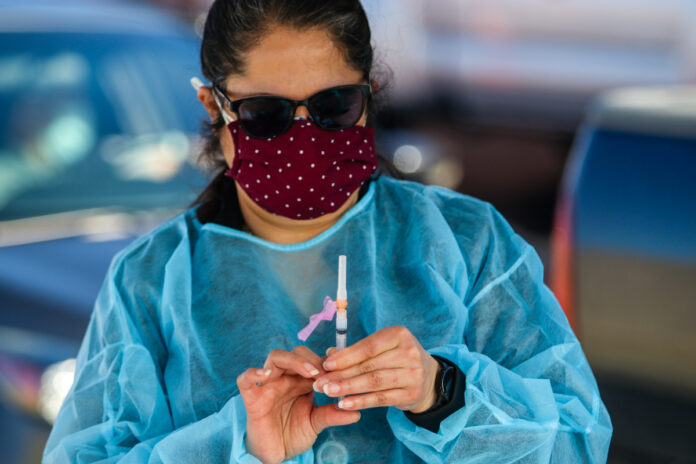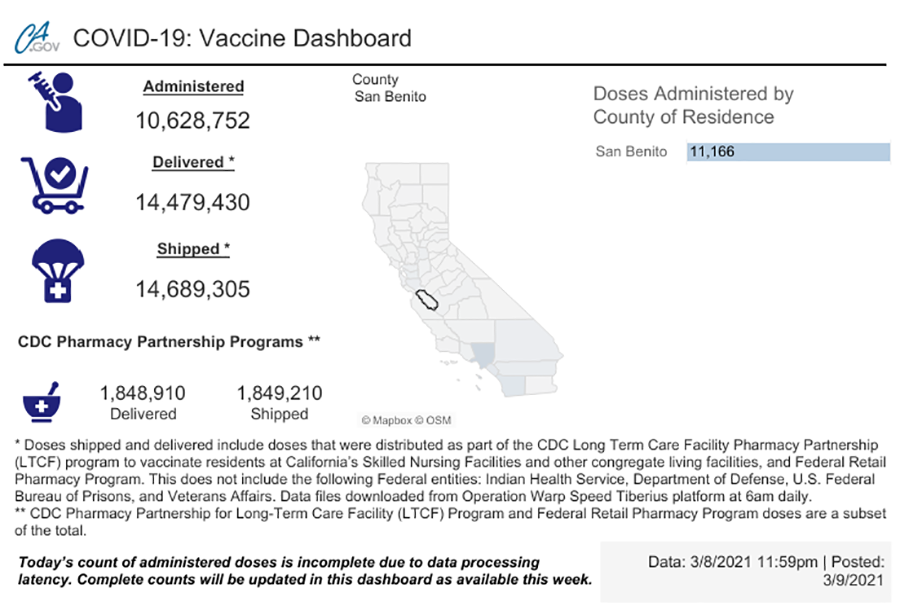
No communities in San Benito County qualify for the California Department of Public Health’s vaccine equity plan, which Gov. Gavin Newsom last week pitched as a way for the state to prioritize disadvantaged and Latinx communities that have seen a disproportionate impact from the pandemic.
Under the plan, the state was to set aside 40 percent of its vaccines for communities in the lowest quartile of its Healthy Places Index (HPI). The HPI provides overall scores and data that predict life expectancy and compare community conditions that shape health such as education levels and income, among other things.
In San Benito County, there are three census tracts in Hollister that fall in the second lowest quartile of the HPI map. The census tract in the larger San Juan Bautista area also falls in that quartile. But the state plan goes by zip codes, which are much larger geographical areas than census tracts.
“Unfortunately, San Benito County is dominated by one zip code and we’re not going to be participating,” Supervisor Bob Tiffany said of the state’s new plan at the board’s March 9 meeting. “That is a concern but hopefully we can work through that.”
But that’s a refrain heard often among local officials lately, as San Benito County has received far fewer doses of Covid-19 vaccine than similar counties, according to discussion at the March 9 board of supervisors meeting.
County officials pointed out other areas where the state is deficient in data tracking. County Office of Education Superintendent Krystal Lomanto told the board that state officials have counted only 136 education workers in San Benito County. Lomanto said that’s not even close to correct, as the county has about 1,400 education workers who qualify for the Covid-19 vaccine.
“We are committed to support the board of supervisors any way we can in the education sector to support receiving additional allocations of vaccinations,” Lomanto said March 9.
Lomanto added her office’s goal is to get all education workers in the county vaccinated by the end of this month, and they need about 600 more vaccines in order to do that.
On March 8, Bay Area lawmakers were ready to hold a press conference to call on state officials to alter the plan, but abruptly canceled the gathering to instead reportedly meet with those representatives.
“The Governor’s Office has expressed a committed (sic) to providing a more formal response to the concerns expressed by Bay Area communities on the vaccine equity rollout issues within the next 24 hours,” State Senator Dave Cortese (D-San Jose) said in a statement. “We are working collaboratively with them and are optimistic that hard-hit areas in the Bay Area that were overlooked will now be included in the state’s prioritization.
“Not every community has felt the effects of this pandemic equally. We need targeted efforts to address the longstanding racial and economic disparities that have been only intensified by Covid-19.”
Only 2 percent of Bay Area residents qualify for the state’s plan. That’s despite the fact that the Bay Area makes up 20 percent of California’s population, and that several communities have been deeply impacted by the pandemic both economically and health-wise. Santa Clara County, for example, has no zip codes that qualify for the plan.
Cortese said the state should instead recalibrate its definition of “hard-hit Covid-19 impacted communities based on census tract data from counties so that no hard-hit census tracts are left behind.”
According to state data, 40 percent of Covid-19 cases and deaths have occurred in the lowest quartile of the HPI. The rate of infections for households making less than $40,000 per year (11.3 percent) is more than double that of households with an income of $120,000 or more (5.2 percent). At the same time, California’s wealthiest populations are being vaccinated at nearly twice the rate of its most vulnerable populations.
San Benito County’s lack of vaccine supply is not a new complaint for local officials and providers, as they have been pleading with the state for a more “equitable” share of vaccinations for weeks.
County Interim Public Health Officer David Ghilarducci told the board that only 16 percent of the county’s residents have been vaccinated. That lags significantly behind the state’s overall vaccination rate of 25 percent. Ghilarducci said his office has continued to notify the state of the “disparity.”
“They’re all aware of the relative maldistribution of vaccine to San Benito County, and we hope this gets rectified soon,” Ghilarducci said.
Ghilarducci added that the county’s prevailing “theory” on why San Benito has received such a lower vaccine allocation than other counties is the absence here of “multi-county entities.” These are large healthcare organizations such as Kaiser Permanente and Sutter. These companies receive vaccine dosage allocations directly from the federal government, adding to the overall supply in counties where they operate.
“They were getting this kind of side supply that smaller counties like ours were not getting,” Ghilarducci said.

Newsom last week also emphasized the toll the pandemic has had on Latinx communities. According to state data, about 55 percent of the state’s 3.5 million cases have been in people of Latinx descent. Those Californians have also accounted for roughly 46 percent of the state’s 54,000 Covid-19-related deaths.
Local data shows that Latinx residents make up 79 percent of cases when county data is filtered by ethnicity.
The county has administered more than 11,166 vaccinations, according to most recent data presented by the state as of March 9, and 24.3 percent of those vaccines have gone to Latinx residents. In addition, multi-race residents have received about 6.2 percent of the vaccines in San Benito County. White residents have received 23.6 percent of the county’s vaccines.
San Benito County is currently vaccinating Phase 1B: Tier 1, which includes those age 65 and older. It also covers those in the food and agriculture sectors, along with education and childcare, and Emergency Services.
Supervisor Kollin Kosmicki suggested the county write a new letter to Blue Shield, which will soon take over all distribution of Covid-19 vaccines in California. He added that the county is “falling through the cracks” in trying to get locals vaccinated, and will only fall further behind with seasonal farmworkers arriving in the coming weeks.
“We really have to stand up and demand a correction to this issue,” Kosmicki said. “There is a solution—it’s to give the counties that have been short changed on vaccinations more doses going forward.”
County to begin using state’s MyTurn system
County officials announced that the public health department transitioned away from its online Covid-19 vaccination interest portal. Instead, they’ll be utilizing the state’s MyTurn system, which allows all Californians to register when they are eligible for vaccinations.
MyTurn was first launched in Los Angeles and San Diego counties. The system allows vaccine providers to input data immediately, giving a real-time look at the number of shots administered both regionally and statewide, according to San Benito County officials.
San Benito County first launched its Covid-19 vaccine interest form on Jan. 14. Since then there’s been approximately 13,500 residents registered, said county officials.
However, the county is not able to migrate their data into the state’s system, which means that residents who previously registered on the county’s website will need to register on MyTurn.
All individuals registered on the interest portal will be notified via email with a direct link to the MyTurn registration on March 10. The website is available in English and Spanish.
Those without internet access can call 1-833-422-4255 to connect with an operator directly in English or Spanish. There’s also an additional 254 languages to choose via a third-party operator.
For more information visit sbccovid19.us or covid19.ca.gov/vaccines/. Residents can also call 2-1-1 for resource information.
Additional reporting by Tony Nuñez of The Pajaronian









